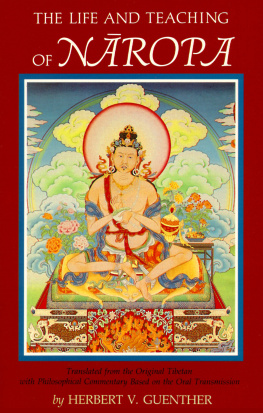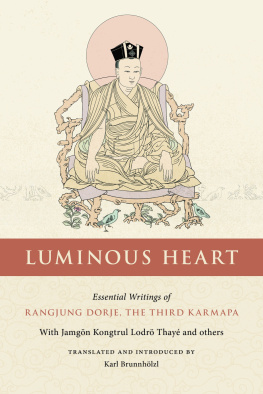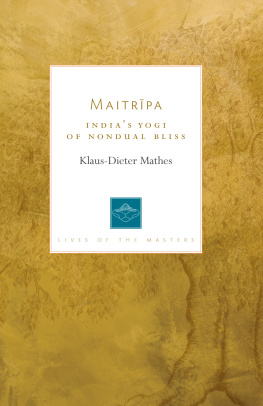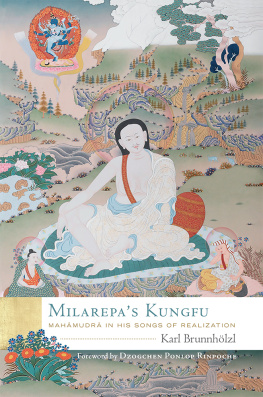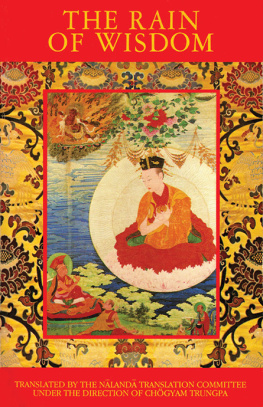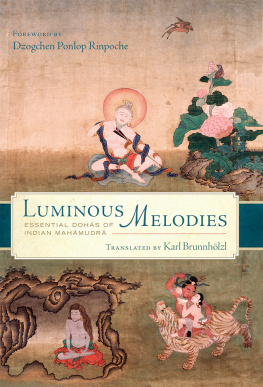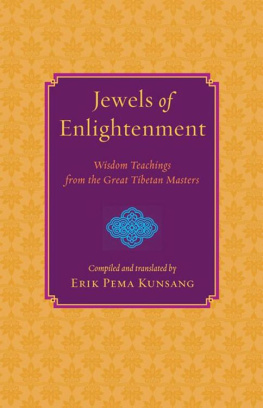THE LIFE OF MARPA THE TRANSLATOR
SEEING ACCOMPLISHES ALL
Tsang Nyn Heruka
Translated from the Tibetan by the Nland Translation
Committee under the direction of Chgyam Trungpa

SHAMBHALA
Boulder
2017
Sign up to receive news and special offers from Shambhala Publications.

Or visit us online to sign up at shambhala.com/eshambhala.
Nland Translation Committee
CHGYAM TRUNGPA, DIRECTOR
LAMA UGYEN SHENPEN
LOPPN LODR DORJE HOLM
LARRY MERMELSTEIN, EXECUTIVE DIRECTOR
CATHRYN STEIN ABATO
DAVID COX
DANA DUDLEY
TONY DUFF
CHRISTINE KEYSER
SHERAP CHDZIN KOHN
DEREK KOLLEENY
ROBIN KORNMAN
JUD LEVINSON
MARK NOWAKOWSKI
REGINALD A. RAY
JOHN ROCKWELL, JR.
SUSAN SCHULTZ
ROBERT VOGLER
IVES WALDO
SCOTT WELLENBACH
GERRY WIENER
SHAMBHALA PUBLICATIONS, INC.
4720 Walnut Street
Boulder, Colorado 80301
www.shambhala.com
1982 by Chgyam Trungpa
Cover design by Chgyam Trungpa
All rights reserved. No part of this book may be reproduced in any form or by any means, electronic or mechanical, including photocopying, recording, or by any information storage and retrieval system, without permission in writing from the publisher.
LIBRARY OF CONGRESS CATALOGING-IN-PUBLICATION DATA
Gtsan-smyon He-ru-ka, 14521507.
The life of Marpa the translator.
Translation of: Mar-pa-mam-thar.
Reprint. Originally published: Boulder: Praja Press, 1982.
1. Mar-pa Chos-kyi-blo-gros, 10121097. 2. Bka-rgyud-par lamasChinaTibetBiography. I. Nalands
Translation Committee. II. Title.
BQ7679.9.M377G7713 1986 294.39230924 [B]
86-11837
eISBN 9780834840980
ISBN 9781570620874 (pbk.)
BVG 01
ILLUSTRATIONS
. Detail from a thangka painted by Karshu Gnpo Dorje, from a series of lineage thangkas at Rumtek Monastery in Sikkim, India. Photograph used by the gracious permission of the late His Holiness the Sixteenth Gyalwa Karmapa, Rangjung Rikpe Dorje.
, the wife of Marpa. Detail from the above thangka by Karshu Gnpo Dorje.
. The stylized monogram of the Klacakra mantra, known as the All-Powerful Ten, consisting of the syllables HA K-A MA LA VA RA YA-.
, the principal yidam of Marpa. Detail from the above thangka by Karshu Gnpo Dorje.
. This shrine building houses a large Vajravrh statue, which is said to have been located here since the time of Marpa. Phamthing is presently known as Parpheng, Nepal. Photograph courtesy of Timothy and Elizabeth Olmsted.
. This is the entire above-mentioned thangka by Karshu Gnpo Dorje. Marpas principal yidam, Hevajra in consort with Nairtmy, is in the upper right. Directly above Marpa is the Sekhar, built by Milarepa, and above that is Marpas dharma center of Trowo valley. On Marpas left is his wife Dagmema, and below her is his student Ngoktn. To the left, below, are Marpas students Metn and Tsurtn (bottom). Below, in the middle, is the protectress Vetl.
, an important mahkl (protector of the dharma) of the Kagy lineage since the time of Nropa and Marpa. Detail from the above thangka by Karshu Gnpo Dorje.
The Life of Marpa the Translator is the first translation to appear in the Biographies of the Ngetn Lineage Series. Ngetn (T: ngesdon; S: ntrtha) means direct, true, or ultimate meaning. In the Tibetan tradition, it refers specifically to the highest level of teachings given by kyamuni Buddha during his lifetime, in his various forms as teacher of hnayna, mahyna, and vajrayna Buddhism. Thus the teachers of the ngetn lineage are understood to be those Tibetan masters who practiced, studied, realized, and taught these ultimate teachings of the Buddha, thereby causing the buddhadharma to flourish. The great eleventh-century Tibetan teacher, Marpa of Lhotrak, was just such a master, and embodied this ideal in his life in a direct, practical, and unusually complete way. Moreover, he did so through his efforts to translate (in both literal and figurative senses) the authentic buddhadharma from India to Tibet. Since this series seeks to further just that same end, rendering the buddhadharma from Tibetan into the Western idiom, it is particularly appropriate that The Life of Marpa is the first biography of the present series.
In accordance with the longstanding Buddhist tradition of translation, this work has been produced by a collaborative effort. Within the Nland Translation Committee, a core group of translators prepares a first draft, which is then carefully reviewed with Lama Ugyen Shenpen, who is a native of East Tibet and well studied in the English language and all facets of Tibetan Buddhism. Having thus prepared a second working draft, this is presented to the director, Vajrcrya the Venerable Chgyam Trungpa, Rinpoche, and with him we repeat the meticulous reading of the entire text. The Vajrcryas accomplishment in both Tibetan and English coupled with his own realization sparks a delightful feast of language and meaning. The text is then reworked a number of times by the core group and other members of the committeerevising, editing, and polishing the English. Research into technical matters continues, and many portions of the translation are often scrutinized again by the Vajrcrya.
Following the early directives of the Buddha, we strive to translate into a modern idiom that is both accurate and useful for practitioner and scholar alike. Rather than straining often inadequate and approximate English phraseology for key Buddhist terminology and concepts, we commonly render these in the ancient lingua franca of Buddhist culture, classical Sanskrit. While this demands more from particularly the nonscholarly reader, we feel that only in this way is the precision, accuracy, and brilliance of the teachings left uncompromised. Others may criticize that the Sanskrit does not fully encompass the range of meanings of the Tibetan term; this is often true. However, we try to remedy this potential shortcoming by appending a glossary of such terms, indicating something of the rich and varied meanings given to these words by the living Buddhist tradition of Tibet. Much of the glossary to this volume was originally compiled for The Rain of Wisdom; this has been adapted to accord with the terminology found in this biography.
In preparing this translation of The life of Marpa the Translator: Seeing Accomplishes All (T: sgra-bsgyur mar-pa lo-tsi rnam-thar mthong-ba don-yod) two complete editions were used: a modern handwritten text (Varanasi: E. Kalsang, 1970) and a reproduction of a late nineteenth-century Tengyeling (T: bstan-rgyas gling) edition entitled Bka-brgyud-pa Hagiographies, compiled and edited by Khams-sprul Don-brgyud nyi-ma, Vol. 1 (Tashijong, India: Sungrab Nyamso Gyunphel Parkhang, Tibetan Craft Community, 1972). In addition, two partial editions were consulted: sections of the Kagy Gurtso (T: bka-brgyud mgurmtsho; translated by the Nland Translation Committee and published under the title, The Rain of Wisdom [Boulder & London: Shambhala, 1980]) and La Vie de Marpa (Paris: Librairie Orientaliste Paul Geuthner, 1937) edited and translated by Jacques Bacot. In all these editions, only minor variant readings were found, mainly differences in spellinga common inconsistencywhich, however, did lead to some differences between our translation and that of Bacot. Bacots French translation has the virtues and faults of a pioneering work. He made the basic life story of Marpa accessible, yet made a number of errors, mostly due to his unfamiliarity with vajrayna doctrine and practice. Moreover, he only translated roughly one-third of the entire biography and omitted almost all of the songs. These shortcomings have prompted our own efforts to make available in English the entire life example of Marpa the Translator.
Next page

